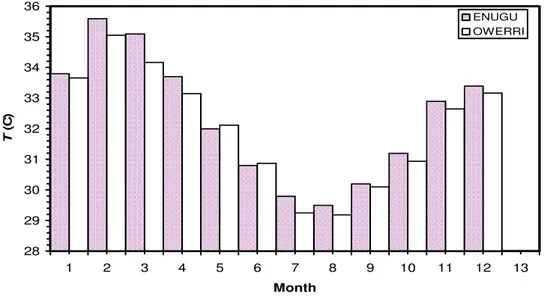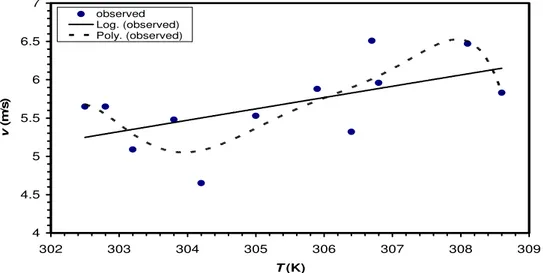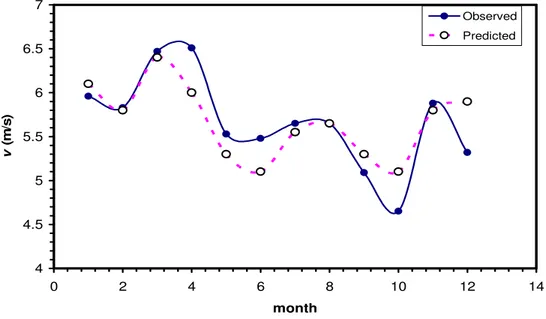E
NERGY AND
E
NVIRONMENT
Volume 4, Issue 6, 2013 pp.1053-1060
Journal homepage: www.IJEE.IEEFoundation.org
Empirical models for predicting wind potential for wind
energy applications in rural locations of Nigeria
F. C. Odo
1,2, G. U. Akubue
1, S. U. Offiah
1, P. E. Ugwuoke
11 National Centre for Energy Research and Development, University of Nigeria, Nsukka, Nigeria. 2 Department of Physics and Astronomy, University of Nigeria, Nsukka, Nigeria.
Abstract
In this paper, we use the correlation between the average wind speed and ambient temperature to develop models for predicting wind potentials for two Nigerian locations. Assuming that the troposphere is a typical heterogeneous mixture of ideal gases, we find that for the studied locations, wind speed clearly correlates with ambient temperature in a simple polynomial of 3rd degree. The coefficient of determination and root-mean-square error of the models are 0.81; 0.0024 and 0.56; 0.0041, respectively, for Enugu (6.40N; 7.50E) and Owerri (5.50N; 7.00E). These results suggest that the temperature-based model can be used, with acceptable accuracy, in predicting wind potentials needed for preliminary design assessment of wind energy conversion devices for the locations and others with similar meteorological conditions.
Copyright © 2013 International Energy and Environment Foundation - All rights reserved.
Keywords: Energy; Renewable energy; Wind.
1. Introduction
In the present scenario of rapid depletion of conventional energy resources, one of the six renewable energy sources identified as being attractive for research and development is wind. In many rural locations of Nigeria, where there is no access to grid-connected electricity, wind energy could provide a cost effective option for rural electrification. Most agricultural activities take place in these remote locations with no access to energy and water. A wind-electric pumping system is ideally suited for irrigation and other water pumping activities required in farm settlements that are not connected to the national grid. Such a system can also provide drinking water for individual households or for small village water schemes.
collection in many rural locations, where installation of wind turbines for utility generation may be more useful. Information on wind resources for these rural sites is only obtainable by extrapolation from cities with similar meteorological conditions. Thus, for these locations, empirical models become inevitable. In previous papers [6-8], available wind data in Enugu and environs, were modeled in terms of Weibull distribution and utility generation. Little or no particular attention had been paid to developing empirical models for estimating wind potentials in these areas where measured data is not available. In this paper, empirical models are proposed for prediction of wind speed, which is required for preliminary design assessment of wind devices for wind sites where reliable data is not readily available, using linear least square (LLS) regression technique. Results from this study will, no doubt, be useful to local designers and manufacturers of wind turbines for the studied locations in Nigeria.
2. Materials and method
The maximum power that can be extracted from the wind at any speed (v) is given by a cubic function of the form [3]:
3
2
1
Av
C
P
=
pρ
(1)where
C
pis the power coefficient,ρ
is the density of the air and A is the area swept by the blade of theconversion device.
Thus, the power derivable from a particular wind turbine depends on the height (h) of installation above
the ground
⎟⎟
⎠
⎞
⎜⎜
⎝
⎛
∝
ρ
1
h
according to the Hellman’s exponential law given [1, 3] by:α
⎟⎟
⎠
⎞
⎜⎜
⎝
⎛
=
0
0
h
h
v
v
(2)
where h0 is any reference height and v0 is the wind speed at h0, while αis the Hellman’s constant.
Equation (2) suggests that the derivable power increases with increasing height only if the change in density of air is negligible. It has been shown [3] that within the troposphere (h≤ 10km) the density of air varies very little for any location.
If the troposphere is considered to be a mixture of ideal gases, the principle of equipartition of energy suggests that, at any absolute temperature (T), the translational kinetic energy (E) of a mole of the gas is given by:
RT
E
2
3
=
(3)where R is the universal gas constant.
In thermal equilibrium, the ambient temperature of the air in a region/location is a measure of the average kinetic energy of the constituent air masses. Thus, if the speed of an air mass (m) arises entirely from the combined effects of the thermal motion of the various components, we can write [9]:
RT
mv
2
3
2
1
2=
(4)The last equation therefore suggests a relationship between the wind speed and the absolute temperature of an atmospheric air mass in the form:
φ
ω
T
where ω and
φ
are constants which describe the velocity–temperature (v–T) dependence and are expected to be location specific. For simplicity, equation (5) can be written on logarithmic scales to yield:T
v
log
log
log
≈
ω
+
φ
(6)Equation (6) actually suggests a correlation between the wind speed and ambient temperature (expressed in thermodynamic scale), which could be used to model the wind speed data in order to accurately predict the wind potential of any location.
For the present analyses, we use 25-year (1977-2002) meteorological data of Enugu (6.40N; 7.50E) and Owerri (5.50N; 7.00E) obtained from the meteorological data bank of Nigerian Meteorological Agency (NIMET). The data provides time series information on daily average of wind speed and ambient temperature, at 10m meteorological height, from where the monthly and yearly mean values were calculated. Time series analysis was applied to study the climatology of wind and ambient temperature in order to develop temperature-based models for predicting wind speed for the two locations.
3. Results and discussion
Time series analysis of meteorological data is not only useful in understanding the pattern of variation, but also to place some constraints on the climatology of any location [10]. The time series distributions of the monthly average wind speed for the two locations are shown in Figure 1. The distributions give annual mean values of 5.7 ± 0.5 m/s and 3.3 ± 0.3 m/s, respectively, for Enugu and Owerri. It could be observed in Figure 1 that maximum wind speed of 6.5 m/s occurred in Enugu during the month of April, while minimum speed of 4.6 m/s was observed in the month of October. Similarly, maximum speed of 3.7 m/s was observed in the month of April, with a minimum speed of 2.6 m/s observed in November for Owerri.
2.5 3 3.5 4 4.5 5 5.5 6 6.5 7
1 2 3 4 5 6 7 8 9 10 11 12 13
Month
v
(
m
/s
)
ENUGU OWERRI
Figure 1. Time series distributions of wind speed for Enugu and Owerri
28 29 30 31 32 33 34 35 36
1 2 3 4 5 6 7 8 9 10 11 12 13
Month T (C ) ENUGU OWERRI
Figure 2. Time series distributions of ambient temperature for Enugu and Owerri
The plots of the observed wind speed as a function of ambient temperature for Enugu and Owerri are respectively shown in Figures 3 and 4. To determine the exact form of the relationship between wind speed and ambient temperature (v –T relation), equation (6) is fitted to each of the plots by simple regression analysis. The results give:
)
34
253
(
)
ln(
)
4
.
10
2
.
45
(
ln
v
=
±
T
−
±
(7)and
)
2
.
5
(
7
.
78
)
ln(
)
6
.
1
3
.
14
(
ln
v
=
±
T
−
±
(8)Respectively, for Enugu and Owerri. Furthermore, correlation statistics were applied to the data in order to determine the degree of association between the two parameters. The correlation coefficient is a non parametric statistic which determines the degree of association between two data sets and is defined [11] as:
(
)
( )
2 1 1 2 1 21
⎪
⎪
⎭
⎪⎪
⎬
⎫
⎪
⎪
⎩
⎪⎪
⎨
⎧
−
−
−
=
∑
∑
= = N i i N i i iv
v
T
v
r
(9)where N is the number of observations in each data set and v is the average wind speed value.
This statistic varies from 0 (for a null association) to ±1 (for a perfect association). The corresponding correlation coefficients are r ~ 0.6, for Enugu and r ~ 0.3, for Owerri. The correlations are statistically significant at 95% confidence. However, the correlation results seem to suggest that equation (6) may not be very unique in expressing the form of the v - T relation, which could accurately predict v from T,for every location. In particular, the results seem to suggest that while the model may be fairly good for predicting wind speed for Enugu, it may be less important for Owerri location.
6 2
3
42
.
58
13022
10
05
.
0
+
−
+
−
=
T
T
T
v
(10)and
6 2
3
32
.
46
9917
10
04
.
0
+
−
+
−
=
T
T
T
v
(11)with corresponding correlation coefficients of 0.81 and 0.56, respectively, for Enugu and Owerri. It could be observed from the correlation results that the polynomial model appears to be better by some order of magnitude in predicting wind speed from the ambient temperature data of the studied locations. This is, nevertheless, in good agreement with a recent work by Bala [12], in which many meteorological parameters correlate significantly with the month of the year in simple polynomial functions, for some cities in north-western zone of Nigeria.
4 4.5 5 5.5 6 6.5 7
302 303 304 305 306 307 308 309
T(K)
v
(m
/s
)
observed Log. (observed) Poly. (observed)
Figure 3. Plot of average wind speed as a function of ambient temperature for Enugu
2.5 2.7 2.9 3.1 3.3 3.5 3.7 3.9
301 302 303 304 305 306 307 308 309
T (K)
v (
m
/s)
Figure 4. Plot of average wind speed as a function of ambient temperature for Owerri
polynomial models using root mean square error (RMSE) statistic, which is a statistic that determines the degree of departure of two data sets from a supposed association and is defined [13] as:
(
)
21 2
1
⎥ ⎦ ⎤ ⎢
⎣ ⎡
− =
∑
vi TiN
RMSE (12)
The results give 0.0024 and 0.0041 for Enugu and Owerri, respectively. All these results suggest that within the limits of statistical errors, the temperature-based polynomial models can be used with acceptable accuracy for prediction of wind potentials in rural areas where measured wind data are not readily available, especially those with similar meteorological conditions to the studied locations.
4 4.5 5 5.5 6 6.5 7
0 2 4 6 8 10 12 14
month
v
(m
/s
)
Observed
Predicted
Figure 5. Observed and predicted monthly average wind speed for Enugu
2.5 2.7 2.9 3.1 3.3 3.5 3.7 3.9
0 2 4 6 8 10 12 14
month
v
(
m
/s
)
Observed Predicted
Figure 5. Observed and predicted monthly average wind speed for Owerri
4. Conclusion
series analyses show that wind speed scales with ambient temperature in the studied locations and the climatology of wind in the locations are essentially similar. Wind speed – temperature (v – T) relations are developed for prediction of wind potentials. For the studied locations, the observed v - T data are best fitted with simple polynomials of the 6th degree, with significant correlations (r > 0.5) and very low prediction errors (RMSE ≤ 0.004). These results strongly suggest that the models can be used, with acceptable accuracy for prediction of wind speed needed for preliminary design assessment of wind potentials for the locations. The models may also be applicable to other locations with similar meteorological conditions.
References
[1] Gipe, P. Wind Power, Renewable Energy for Homes, Farms and Business, pp 34, Chelsea Green, USA. 2004.
[2] Enibe, S. O.A Method of Assessing Wind Energy Potential In Nigerian Locations, Nig. J. of Solar Energy, 1987, 6, 14.
[3] Walker, J. F. and Jenkins, S. Wind Energy Technology, pp 86, John Willy & Sons, Chinchester, 1997.
[4] Vosburgh, P. N. Commercial Application of Wind Energy, pp 17, Van Nostrand Rainhold, New York, 1983.
[5] Aidan, J. and Ododo, J. C. Wind energy Potentials of some northern Nigerian Cities, Nig. J. of Solar Energy, 2008, 19, 22.
[6] Ugwuoke, P. E., Bala, E. J., Sambo, A. S. and Argungu, G. M. Assessment of Wind Energy Potentials for Electricity Generation in the Nigerian Rural Setting, Nig. J. of Solar Energy, 2008, 19, 98.
[7] Odo, F. C., Offiah, S. U. and Akubue, G. U. Prediction of Wind Potential in Nsukka using Weibull Distribution, Nig. J. of Solar Energy, 2011, 22, 85.
[8] Odo, F. C., Offiah, S. U. and Ugwuoke, P. E. Weibul Distribution-based Model for prediction of Wind Potential in Enugu, Nigeria, Adv. Appl. Sci. Res., 2012, 3, 1202.
[9] Sears, F. W. An Introduction to Thermodynamics and Statistical Mechanics, pp 49, Addison-Wesley Massachusetts,1953.
[10] Kamau, J. N., Kinyua, R. and Gathua, J. Six Years of Wind Data for Marsabit: an Analysis of Wind Energy Potentials, Renewable Energy, 2010, 35, 1298.
[11] Aalen, O. O. Annals of Statistics, 1978, 6, 701.
[12] Bala, E. J. Analysis of some meteorological data for four cities in north-western zone of Nigeria, Nig. J. of Renewable Energy, 2001, 9, 1039.
[13] Joanes, D. N. and Gill, C. A. Comparing Measures of Sample Skewness and Kurtosis, J. Royal Stat. Soc., 1998, 47, 183.
F. C. Odo obtained a B.Sc Degree in Physics in 1998, M. Sc Astrophysics in 2006 and Ph.D in Physics in 2012, with bias in Astrophysics and Space Science, all from University of Nigeria, Nsukka, Enugu State of Nigeria. He is currently doubles as a Research Fellow at the National Centre for Energy Research and development and Lecturer in the Department of Physics and Astronomy, University of Nigeria, Nsukka. He has published a number of papers in the field of Astrophysics and Wind Energy in reputable international journals, including the Journal of Astrophysics and Astronomy (Springer) and International Journal of Energy Science (World academic pub.). Dr. Odo is a member of Solar Energy Society of Nigeria as well as Nigerian Astronomical Society.
S. U. Offiah holds B.Sc and M. Sc Degrees in Physics from the University of Nigeria, Nsukka in 2005 and 2010 respectively. He is a Research Fellow at the National Centre for Energy Research and Development, University of Nigeria, Nsukka. He has also co-authored a good number of research publications in reputable journals with research interest in solar photovoltaic and thin film technologies. Mr. Offiah is a member of Solar Energy Society of Nigeria.
P. E. Ugwuoke obtained a Ph.D degree in Physics in 2005 with emphasis in Solar Energy from the University of Nigeria, Nsukka. He is the Chief Scientific Officer at the Energy Commission of Nigeria Headquatres, Abuja. He has published over twenty five research papers in reputable journals. His research interest is Renewable Energy Technologies. Dr. Ugwuoke is a member of Nigerian Institute of Physics as well as the Solar Energy Society of Nigeria.



